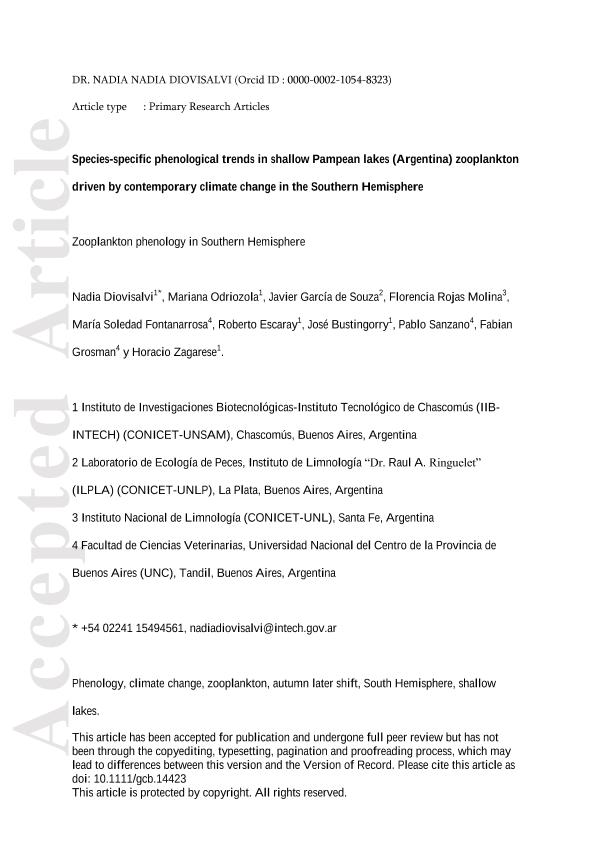Mostrar el registro sencillo del ítem
dc.contributor.author
Diovisalvi, Nadia Rosalia

dc.contributor.author
Odriozola, Mariana Paola

dc.contributor.author
Garcia de Souza, Javier Ricardo

dc.contributor.author
Rojas Molina, Florencia Mercedes

dc.contributor.author
Fontanarrosa, María Soledad

dc.contributor.author
Escaray, Roberto Ulises

dc.contributor.author
Bustingorry, Jose Fernando

dc.contributor.author
Sanzano, Pablo Miguel

dc.contributor.author
Grosman, Manuel Fabián

dc.contributor.author
Zagarese, Horacio Ernesto

dc.date.available
2019-08-29T20:23:33Z
dc.date.issued
2018-11
dc.identifier.citation
Diovisalvi, Nadia Rosalia; Odriozola, Mariana Paola; Garcia de Souza, Javier Ricardo; Rojas Molina, Florencia Mercedes; Fontanarrosa, María Soledad; et al.; Species-specific phenological trends in shallow Pampean lakes’ (Argentina) zooplankton driven by contemporary climate change in the Southern Hemisphere; Wiley Blackwell Publishing, Inc; Global Change Biology; 24; 11; 11-2018; 5137-5148
dc.identifier.issn
1354-1013
dc.identifier.uri
http://hdl.handle.net/11336/82531
dc.description.abstract
The relationship between the timing of recurrent biological events and seasonal climatic patterns (i.e., phenology) is a crucial ecological process. Changes in phenology are increasingly linked to global climate change. However, current evidence of phenological responses to recent climate change is subjected to substantial regional and seasonal biases. Most available evidence on climate-driven phenological changes comes from Northern Hemisphere (NH) ecosystems and typically involves increases in spring and summer temperatures, which translate into earlier onsets of spring population developments. In the Argentine Pampa region, warming has occurred at a much slower pace than in the NH, and trends are mostly restricted to increases in the minimum temperatures. We used zooplankton abundance data from Lake Chascomús (recorded every two weeks from 2005 to 2015) to evaluate potential changes in phenology. We adopted a sequential screening approach to identify taxa displaying phenological trends and evaluated whether such trends could be associated to observe long-term changes in water temperature. Two zooplankton species displayed significant later shifts in phenology metrics (end date of Brachionus havanaensis seasonal distribution: 31 day/decade, onset and end dates of Keratella americana seasonal distribution: 59 day/decade and 82 day/decade, respectively). The timing of the observed shift in B. havanaensis phenology was coincident with a warming trend in the May lake water temperature (4.7°C per decade). Analysis of abundance versus temperature patterns from six additional shallow Pampean lakes, and evaluation of previous experimental results, provided further evidence that the lake water warming trend in May was responsible for the delayed decline of B. havanaensis populations in autumn. This study is the first report of freshwater zooplankton phenology changes in the Southern Hemisphere (SH).
dc.format
application/pdf
dc.language.iso
eng
dc.publisher
Wiley Blackwell Publishing, Inc

dc.rights
info:eu-repo/semantics/openAccess
dc.rights.uri
https://creativecommons.org/licenses/by-nc-nd/2.5/ar/
dc.subject
Autumn Later Shift
dc.subject
Climate Change
dc.subject
Phenology
dc.subject
Shallow Lakes
dc.subject
South Hemisphere
dc.subject
Zooplankton
dc.subject.classification
Otras Ciencias Biológicas

dc.subject.classification
Ciencias Biológicas

dc.subject.classification
CIENCIAS NATURALES Y EXACTAS

dc.title
Species-specific phenological trends in shallow Pampean lakes’ (Argentina) zooplankton driven by contemporary climate change in the Southern Hemisphere
dc.type
info:eu-repo/semantics/article
dc.type
info:ar-repo/semantics/artículo
dc.type
info:eu-repo/semantics/publishedVersion
dc.date.updated
2019-07-26T13:40:10Z
dc.journal.volume
24
dc.journal.number
11
dc.journal.pagination
5137-5148
dc.journal.pais
Reino Unido

dc.journal.ciudad
Londres
dc.description.fil
Fil: Diovisalvi, Nadia Rosalia. Consejo Nacional de Investigaciones Científicas y Técnicas. Centro Científico Tecnológico Conicet - La Plata. Instituto de Investigaciones Biotecnológicas. Instituto de Investigaciones Biotecnológicas "Dr. Raúl Alfonsín" (sede Chascomús). Universidad Nacional de San Martín. Instituto de Investigaciones Biotecnológicas. Instituto de Investigaciones Biotecnológicas "Dr. Raúl Alfonsín" (sede Chascomús); Argentina
dc.description.fil
Fil: Odriozola, Mariana Paola. Consejo Nacional de Investigaciones Científicas y Técnicas. Centro Científico Tecnológico Conicet - La Plata. Instituto de Investigaciones Biotecnológicas. Instituto de Investigaciones Biotecnológicas "Dr. Raúl Alfonsín" (sede Chascomús). Universidad Nacional de San Martín. Instituto de Investigaciones Biotecnológicas. Instituto de Investigaciones Biotecnológicas "Dr. Raúl Alfonsín" (sede Chascomús); Argentina
dc.description.fil
Fil: Garcia de Souza, Javier Ricardo. Consejo Nacional de Investigaciones Científicas y Técnicas. Centro Científico Tecnológico Conicet - La Plata. Instituto de Limnología "Dr. Raúl A. Ringuelet". Universidad Nacional de La Plata. Facultad de Ciencias Naturales y Museo. Instituto de Limnología; Argentina
dc.description.fil
Fil: Rojas Molina, Florencia Mercedes. Consejo Nacional de Investigaciones Científicas y Técnicas. Centro Científico Tecnológico Conicet - Santa Fe. Instituto Nacional de Limnología. Universidad Nacional del Litoral. Instituto Nacional de Limnología; Argentina
dc.description.fil
Fil: Fontanarrosa, María Soledad. Consejo Nacional de Investigaciones Científicas y Técnicas; Argentina. Universidad Nacional del Centro de la Provincia de Buenos Aires. Facultad de Ciencias Exactas. Instituto Multidisciplinario de Ecosistemas y Desarrollo Sustentable; Argentina
dc.description.fil
Fil: Escaray, Roberto Ulises. Consejo Nacional de Investigaciones Científicas y Técnicas. Centro Científico Tecnológico Conicet - La Plata. Instituto de Investigaciones Biotecnológicas. Instituto de Investigaciones Biotecnológicas "Dr. Raúl Alfonsín" (sede Chascomús). Universidad Nacional de San Martín. Instituto de Investigaciones Biotecnológicas. Instituto de Investigaciones Biotecnológicas "Dr. Raúl Alfonsín" (sede Chascomús); Argentina
dc.description.fil
Fil: Bustingorry, Jose Fernando. Consejo Nacional de Investigaciones Científicas y Técnicas. Centro Científico Tecnológico Conicet - La Plata. Instituto de Investigaciones Biotecnológicas. Instituto de Investigaciones Biotecnológicas "Dr. Raúl Alfonsín" (sede Chascomús). Universidad Nacional de San Martín. Instituto de Investigaciones Biotecnológicas. Instituto de Investigaciones Biotecnológicas "Dr. Raúl Alfonsín" (sede Chascomús); Argentina
dc.description.fil
Fil: Sanzano, Pablo Miguel. Universidad Nacional del Centro de la Provincia de Buenos Aires. Facultad de Ciencias Veterinarias; Argentina
dc.description.fil
Fil: Grosman, Manuel Fabián. Universidad Nacional del Centro de la Provincia de Buenos Aires. Facultad de Ciencias Veterinarias; Argentina
dc.description.fil
Fil: Zagarese, Horacio Ernesto. Consejo Nacional de Investigaciones Científicas y Técnicas. Centro Científico Tecnológico Conicet - La Plata. Instituto de Investigaciones Biotecnológicas. Instituto de Investigaciones Biotecnológicas "Dr. Raúl Alfonsín" (sede Chascomús). Universidad Nacional de San Martín. Instituto de Investigaciones Biotecnológicas. Instituto de Investigaciones Biotecnológicas "Dr. Raúl Alfonsín" (sede Chascomús); Argentina
dc.journal.title
Global Change Biology

dc.relation.alternativeid
info:eu-repo/semantics/altIdentifier/doi/http://dx.doi.org/10.1111/gcb.14423
dc.relation.alternativeid
info:eu-repo/semantics/altIdentifier/url/https://onlinelibrary.wiley.com/doi/full/10.1111/gcb.14423
Archivos asociados
